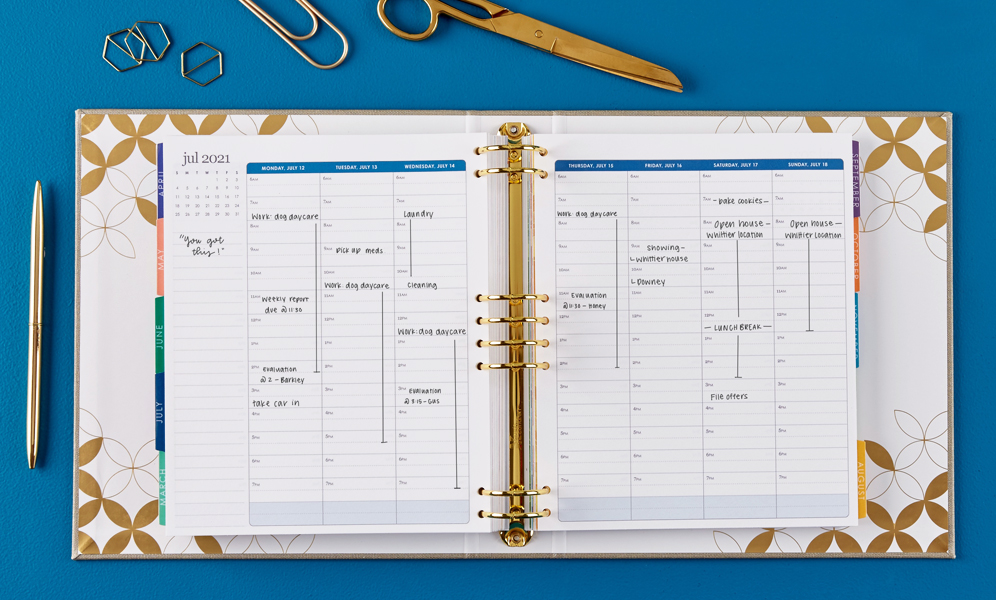How to reduce stress, get organized and increase productivity while working from home in quarantine
So many companies are asking employees to continue to work from home to practice social distancing during the global COVID-19 pandemic. While, given the situation, those who can work from home are no doubt grateful, it does come with its own set of challenges, particularly for those who also have to homeschool kids and/or take care of sick loved ones. Here are nine productivity tips to help you stay organized, reduce stress and get things done while working remotely in self-quarantine.
1. Make sure you bring home everything you need to work remotely.
Since a lot of businesses are temporarily closing their offices, you’ll want to arrange a time when you can safely pick up what you need from the office to set up your home office (if you haven’t already). Common essentials include any work laptops, phones, chargers, paper planners, important documents, office supplies, etc. Don’t forget digital essentials like online access to virtual meetings, internal communication apps, project management systems, company VPN, and more.
Learn more about organization tools that make working from home less stressful and more productive here.
2. Designate and organize a workspace in your home.
To maximize productivity, you’ll want to set aside a room or area of your home that has plenty of natural light, minimum distractions and a comfy chair and desk or table. Once you’ve chosen your workspace, it’s time to set up the equipment you brought from work and make your temporary home office warm and welcoming so you can focus, be comfortable and stay productive.
Read How to Brighten Your Home Office for home office organization and decorating hacks.

3. Adhere to your usual work schedule as much as possible.
While COVID-19 has disrupted just about every schedule everywhere, doing your best to maintain your usual work schedule when working from home will ease the transition and help keep you productive. If you can, start and end work around the same time you normally would if you were physically at work; take your lunch break at the same time; stick to your regularly scheduled meetings; and so on.
4. Understand what’s expected of you while working from home.
If your employer hasn’t communicated what is expected of you while you are working remotely, consider reaching out and asking. Knowing how your job duties are affected by efforts to contain the spread of COVID-19 is vital to not only your job performance but also to reducing work-related and situational anxiety.
5. Get organized and make a plan.
Once you have a clear understanding of what your employer expects of you and you’ve set up your home workspace, it’s time to get organized. Sort and organize your work documents and office supplies, and store your company passwords and remote access info in a secure-but-accessible place. Then, use a planner, agenda, calendar or even a notebook to plan out your work schedule.
Digital planning tools are great when supplemented with paper planning tools because the act of writing a plan by hand helps reduce stress (and we could all use less stress!) and increase information retention and recall.
- Start with big-picture monthly planning. Transfer all important dates, meetings and deadlines from email, Slack, Asana, Wrike, or whatever programs your company uses to one place like your calendar or monthly planner. Leave some room in your calendar because some dates might change.
- Next, plan your weekly schedule. Once you have a birdseye view of what’s on your plate for the next 30 days, you can map out your weekly work-at-home schedule. Note, if you have important personal appointments, obligations, projects, etc., add those to your monthly and weekly schedule too. That way, you won’t overextend yourself by only planning for work-related tasks, leaving your time tight for other important matters.
- Finally, write down daily to-dos. Try to make time at the beginning of each day to jot down a list of to-dos for the day. This daily checklist is a great way to include details you couldn’t fit on your weekly or monthly schedule. Keep in mind how much time you have when making your lists. It’s okay to write a crazy-long list as a first draft; then, edit it down to the day’s top priorities. Doing so not only gives you a working roadmap for the day, but as you check off each item, you’re also encouraging and motivating yourself to stay productive. (It’s so rewarding to CHECK an item off a to-do list!)

6. Keep your work-from-home schedule visible.
Keeping your schedule within view is a simple-but-effective productivity hack. Include a favorite quote or two as motivational reminders to keep up the good work. You can display your schedule on a wall organizer or calendar, desk pad or keep your planner open on your desk.
7. When working from home, remain accessible and responsive online.
This is a big one. No matter how diligent you are at working remotely, if you appear to be offline, or you’re not responsive to emails and other internal communication channels, then you may give the wrong impression to your team and employer. Like tip #3, try to adhere to your usual work cadence as much as possible.
8. Stay on task, but make time for self-care.
While you leverage your digital and paper planning tools to stay focused and track your productivity, remember to take regular breaks to breathe, stay hydrated, eat lunch or a snack, and step away from your designated workspace from time to time. Self-care is vital to boosting and maintaining your productivity while working from home. And during stressful times like these, self-care is vital to your health too!
To learn more about the benefits of self-care, read 7 Kinds of Well-Being to Add to Your Self-Care Routine.
9. Stay flexible under rapidly evolving circumstances.
Planning and organization are key to successfully working from home, but so is adaptability. Plan ahead, but stay flexible so you can adjust your plans when necessary. And above all, be patient with yourself and your coworkers. None of us has any experience dealing with a global pandemic like COVID-19, and the situation is constantly evolving. So, work in some time buffers into your schedule for the unexpected, and remember: just like we’re all in this together, we’ll all get through this together.
Access more Work From Home Resources here.
Visit our Inspiration Center for more planning and productivity tips, home office organization hacks and more.



Comments are closed.